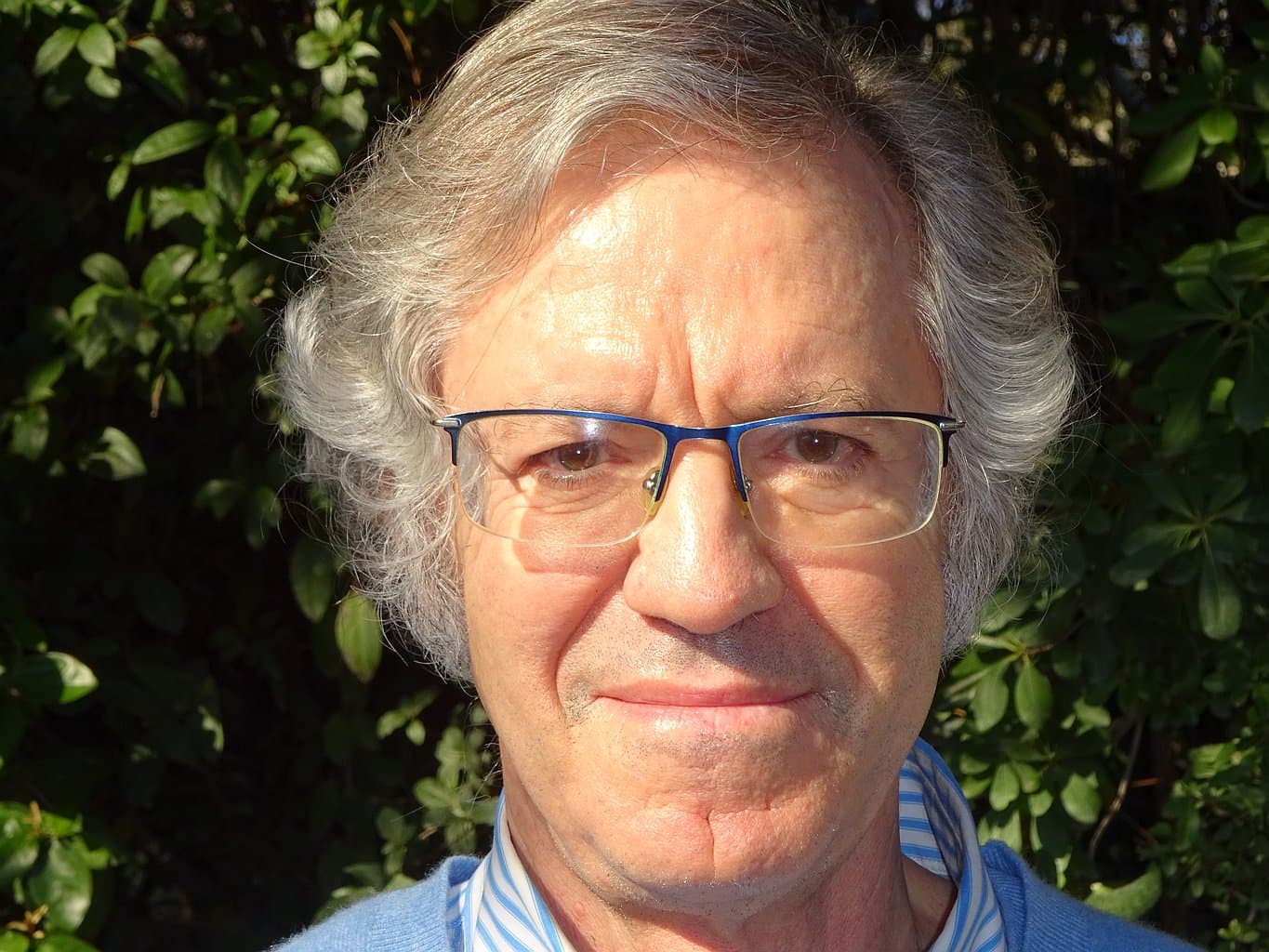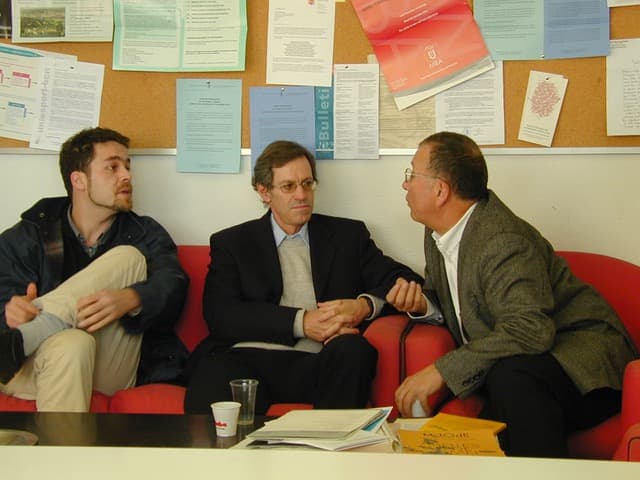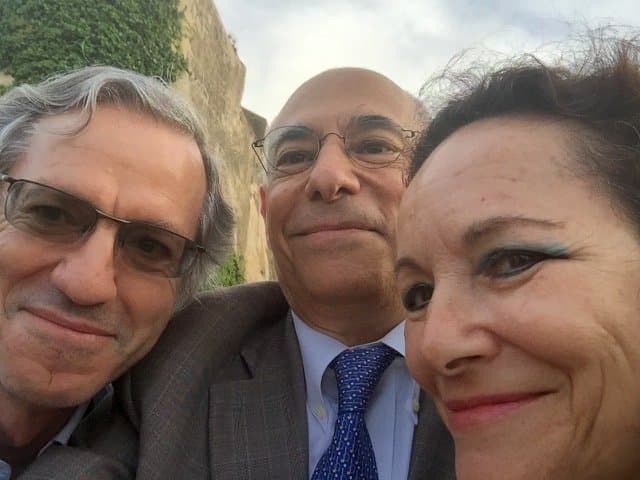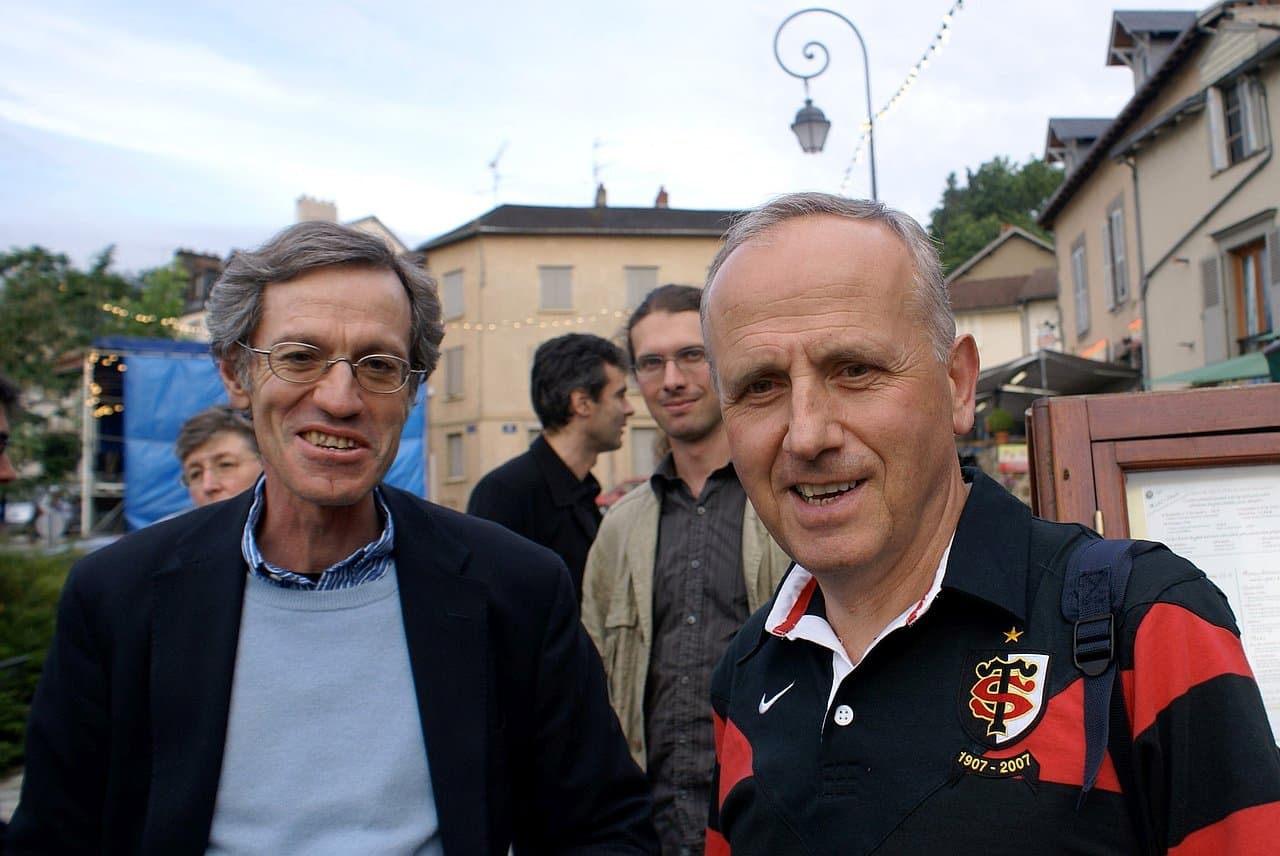Hédy Attouch.
🅭🅯 CC BY 4.0Hédy Attouch, a brilliant student at a Saint-Germain-en-Laye high school, at one point hesitated between continuing higher studies and a career as professional footballer, a field in which he excelled in the junior and youth teams of Stade Saint-Germain. At the insistence of his father, director of a primary school in Versailles, he finally chose the studies which would lead him, after the Louis-le-Grand high school, to the École normale supérieure of Cachan. With his aggregation in hand, Jacques Deny, specialist in potential theory, encouraged him to follow a series of lectures given in Paris VI by Haïm Brézis. In his biography [2 H. Attouch, To whom I am greatly indebted…. J. Convex Anal. 17, 681–699 (2010) ], Hédy writes: I got fascinated by his (i.e., Brézis’s) course, where functional analysis was married with such mysterious objects as multivalued monotone operators and lower semi-continuous convex functions, and which allowed to solve large classes of nonlinear PDEs. Haïm Brézis then jointly proposed to Hédy and Alain Damlamian (whom I did not know at that time, but with whom I subsequently had relations both scientific and friendly) a common research subject whose main idea was to combine, within the same differential inclusion, the monotonicity methods developed by Ky Fan with an application to economics proposed by Claude Henry (a researcher at the Laboratory of Econometrics of the École Polytechnique). This collaboration between Hédy and Alain led them both to complete a doctorate in 1976 at the University of Paris VI (Pierre and Marie Curie) and to publish several joint articles, including a seminal work concerning evolution equations governed by time-dependent subdifferential operators [6 H. Attouch and A. Damlamian, On multivalued evolution equations in Hilbert spaces. Israel J. Math. 12, 373–390 (1972) ].
Hédy’s academic career began in 1971 by obtaining a position as Maître de Conférences at the University of Paris Sud, Orsay. In 1976, he defended his Thèse d’Etat in Paris VI, and his second thesis subject (compulsory at that time) on the theory of cooperative games. The subject had been proposed to him by Jean-Pierre Aubin. After his Thèse d’Etat, he obtained a sabbatical leave during which he went to the United States, where he met several renowned mathematicians: Louis Nirenberg at the Courant Institute, Michael Crandall at University of Wisconsin, Felix Browder at University of Chicago, Terry Rockafellar at University of Washington, Seattle, and Roger Wets at University of Kentucky. It was with the latter that Hédy began active and fruitful cooperative research focused on several interconnected areas such as epigraphic analysis, quantitative analysis of stability of variational systems, variational convergence of functions, multivalued random processes, and the epigraphic law of large numbers. It is from this collaboration with Roger Wets that Hédy obtained one of his famous results with which his international reputation began: Given a sequence of lower semi-continuous and proper convex functions, the sequence epi-converges to a convex function if and only if the graphs of their subdifferentials converge (in the sense of Mosco) to the subdifferential of the limit function, modulo a normalization condition which fixes the integration constant. For readers who are interested, the numerous results obtained during these years of fruitful cooperation with Roger Wets are recorded in Hédy’s book [1 H. Attouch, Variational convergence for functions and operators. Applicable Mathematics Series, Pitman (Advanced Publishing Program), Boston, MA (1984) ] as well as in an article we co-authored on the occasion of an international conference organized at the CIRM [8 H. Attouch and M. Théra, Convergence en analyse multivoque et variationnelle. MATAPLI 36, 22–39 (1993) ]. Another very important result obtained by Hédy, which is central in convex analysis, is the Attouch–Brézis theorem, which gives a sufficient condition for the Fenchel conjugate of the sum of two lower-semi-continuous convex functions to be equal to the exact inf-convolution of their conjugates.
At the very beginning of the 1980s, Hédy was invited to Pisa, where a decisive meeting took place with Ennio De Giorgi, the founder of the topological theory of -convergence, a theory that broadens considerably the framework of variational convergences. Hédy took advantage of this stay and the emergence of homogenization theory to redirect his research towards the study of laws of the physics of composite materials from a macroscopic point of view. In 1983, he became a professor at the University of Perpignan, where he was welcomed by Alain Fougères, who was interested in developing new ideas around integral functionals and variational analysis. The latter suggested creating a new laboratory centred on these themes. This is how the AVAMAC (Variational Analysis and Applications to Mechanics, Automatics and Control) laboratory was born, with Hédy as director. Then, in 1988, he joined the University of Montpellier and more precisely the Convex Analysis Laboratory, where he was welcomed by Jean Jacques Moreau, Charles Castaing and Michel Valadier, all well known for their work on convex analysis, measurable set-valued mappings and Young measures. It was in this laboratory and in this environment, where Lionel Thibault and many others later joined, that Hédy continued his entire career until his retirement. During these years in Montpellier, he trained numerous students, wrote numerous papers, and participated in the transformation of the journal Travaux du Séminaire d’Analyse Convexe into a high-level international journal, the Journal of Convex Analysis.
Hédy sharing a discussion after the Convex Analysis Seminar in Montpellier with Jérome Bolte and Michel Théra.
🅭🅯 CC BY 4.0Hédy with his wife Annie and Bernard Cornet.
🅭🅯 CC BY 4.0I had the pleasure of welcoming Hédy to the Séminaire d’Analyse Non-linéaire et Optimisation that I had created in Limoges in 1987; he was one of my first guests. The chance to know him better and appreciate him came a few years later during a joint stay at UCD (University of California Davis), when we formed a very friendly and mathematically very fruitful relationship. I came alone with my children, my wife not having received authorization from her employer to be on leave for a long period. We rented apartments next to each other and spent a lot of time together, and Hédy and his wife helped me look after my children; we shared meals and excursions, and we played tennis. It was during this stay that Hédy convinced me to try golf at the Davis Golf Course. We both taught, linear programming for him and a calculus course for me. This stay would constitute for me a turning point in my approach to mathematics, which until now had remained abstract. Hédy, who had, more than me, a very good knowledge of physics and mechanics, pushed me to look at mathematics from an angle linked to potential applications. We wrote several articles together. One of them, an article for which we invited Jean-Bernard Baillon to participate, concerns the notion of variational sum for maximally monotone operators [3 H. Attouch, J.-B. Baillon and M. Théra, Variational sum of monotone operators. J. Convex Anal. 1, 1–29 (1994) ]. In [4 H. Attouch, J.-B. Baillon and M. Théra, Weak solutions of evolution equations and variational sum of maximal monotone operators. Southeast Asian Bull. Math. 19, 117–126 (1995) ], we exhibited for an evolution equation the link between the concept of weak solution in the sense of Benilan and Brézis and the concept of variational sum. In addition, we gave an application of the latter to the parabolic evolution equation involving the Schrödinger operator. In relation with Hédy’s early work, we also obtained in uniformly Banach spaces a positive result linking the convergence of subdifferentials with the bounded Hausdorff topology. As far as I know, the complete equivalence in a general Banach space is still an open problem [7 H. Attouch, J. L. Ndoutoume and M. Théra, Epigraphical convergence of functions and convergence of their derivatives in Banach spaces. Sém. Anal. Convexe 20, exp. 9, 9.1–9.45 (1990) ]. Another article, [9 H. Attouch and M. Théra, A general duality principle for the sum of two operators. J. Convex Anal. 3, 1–24 (1996) ], concerns a general concept of duality for nonlinear problems, a concept that encompasses all classical duality relations like Fenchel’s, Toland’s and Clarke–Ekeland. This result shows that the dual of the dual problem is the primal problem, and the primal problem has at least one solution if and only if this is the case for the dual problem. This article, very well cited in the literature as the source of the Attouch–Théra duality principle, was completed during a joint visit at the University of Montreal organized by Francis Clarke.
Busy with various important administrative tasks, I regretted (and I still regret) not having accepted his offer to participate for the part which concerned duality in the writing of his book [5 H. Attouch, G. Buttazzo and G. Michaille, Variational analysis in Sobolev and BV spaces: Applications to PDEs and optimization. Second ed., MOS-SIAM Ser. Optim. 17, Society for Industrial and Applied Mathematics (SIAM), Philadelphia, PA; Mathematical Optimization Society, Philadelphia, PA (2014) ] co-authored by Giuseppe Buttazzo and Gérard Michaille.
Hédy then became passionate about new themes, with an impressive number of different collaborators: Samir Adly, Felipe Alvarez, Radu Boţ, Luis Briceño-Arias, Jérôme Bolte, Alexandre Cabot, Zaki Chbani, Patrick Combettes, Roberto Cominetti, Marc-Olivier Czarnecki, Xavier Goudou, Juan Peypouquet, Patrick Redont, Hassan Riahi, Marc Teboulle and many others. This research was devoted to continuous- and discrete-time approaches and the development of fast algorithmic methods for convex and non-convex optimization problems. More precisely, with his collaborators, Hédy obtained very important results concerning the proximal point algorithm, forward-backward methods, the rapid convergence of inertial dynamics and algorithms with zero asymptotic viscosity, an inertial proximal method for maximally monotone operators via the discretization of a nonlinear oscillator with damping, minimization methods and methods of alternating proximal projections based on the Kurdyka–Łojasiewicz inequality, the convergence of descent methods for semi-algebraic problems, and tame and regularized Gauss–Seidel methods. Despite Hédy’s various invitations, I was not able to participate in this work because I was myself involved with different collaborators in the theory of error bounds; but I closely followed the impressive development of his latest results.
Hédy with Jean-Baptiste Hiriart-Urruty at an international conference (NVA 2007) in Limoges.
🅭🅯 CC BY 4.0In 2021, Hédy received the George B. Dantzig Prize (awarded every three years by SIAM and MOS), jointly with Michel Goemans, for his fundamental contributions to modern variational analysis and nonsmooth optimization, including new notions of variational convergence, the introduction of novel topologies for the study of quantitative stability of variational systems, and their application in algorithm design and analysis, dynamical systems and partial differential equations.
To conclude, how can we talk about Hédy without mentioning his kindness, his tolerance, his goodwill towards his colleagues, his ability to communicate and share. He contributed in an exceptional way to international scientific life by enthusiastically sharing his knowledge, and he leaves a significant mathematical work that his numerous students and collaborators will continue.
Hédy left us on 14 October 2023. Farewell, Hédy! Annie, your wife, who accompanied you to all the conferences to which you were invited, misses you very much, and so does our mathematical community.
References
- H. Attouch, Variational convergence for functions and operators. Applicable Mathematics Series, Pitman (Advanced Publishing Program), Boston, MA (1984)
- H. Attouch, To whom I am greatly indebted…. J. Convex Anal. 17, 681–699 (2010)
- H. Attouch, J.-B. Baillon and M. Théra, Variational sum of monotone operators. J. Convex Anal. 1, 1–29 (1994)
- H. Attouch, J.-B. Baillon and M. Théra, Weak solutions of evolution equations and variational sum of maximal monotone operators. Southeast Asian Bull. Math. 19, 117–126 (1995)
- H. Attouch, G. Buttazzo and G. Michaille, Variational analysis in Sobolev and BV spaces: Applications to PDEs and optimization. Second ed., MOS-SIAM Ser. Optim. 17, Society for Industrial and Applied Mathematics (SIAM), Philadelphia, PA; Mathematical Optimization Society, Philadelphia, PA (2014)
- H. Attouch and A. Damlamian, On multivalued evolution equations in Hilbert spaces. Israel J. Math. 12, 373–390 (1972)
- H. Attouch, J. L. Ndoutoume and M. Théra, Epigraphical convergence of functions and convergence of their derivatives in Banach spaces. Sém. Anal. Convexe 20, exp. 9, 9.1–9.45 (1990)
- H. Attouch and M. Théra, Convergence en analyse multivoque et variationnelle. MATAPLI 36, 22–39 (1993)
- H. Attouch and M. Théra, A general duality principle for the sum of two operators. J. Convex Anal. 3, 1–24 (1996)
Cite this article
Michel Théra, Hédy Attouch, in memoriam. Eur. Math. Soc. Mag. 132 (2024), pp. 43–45
DOI 10.4171/MAG/194



